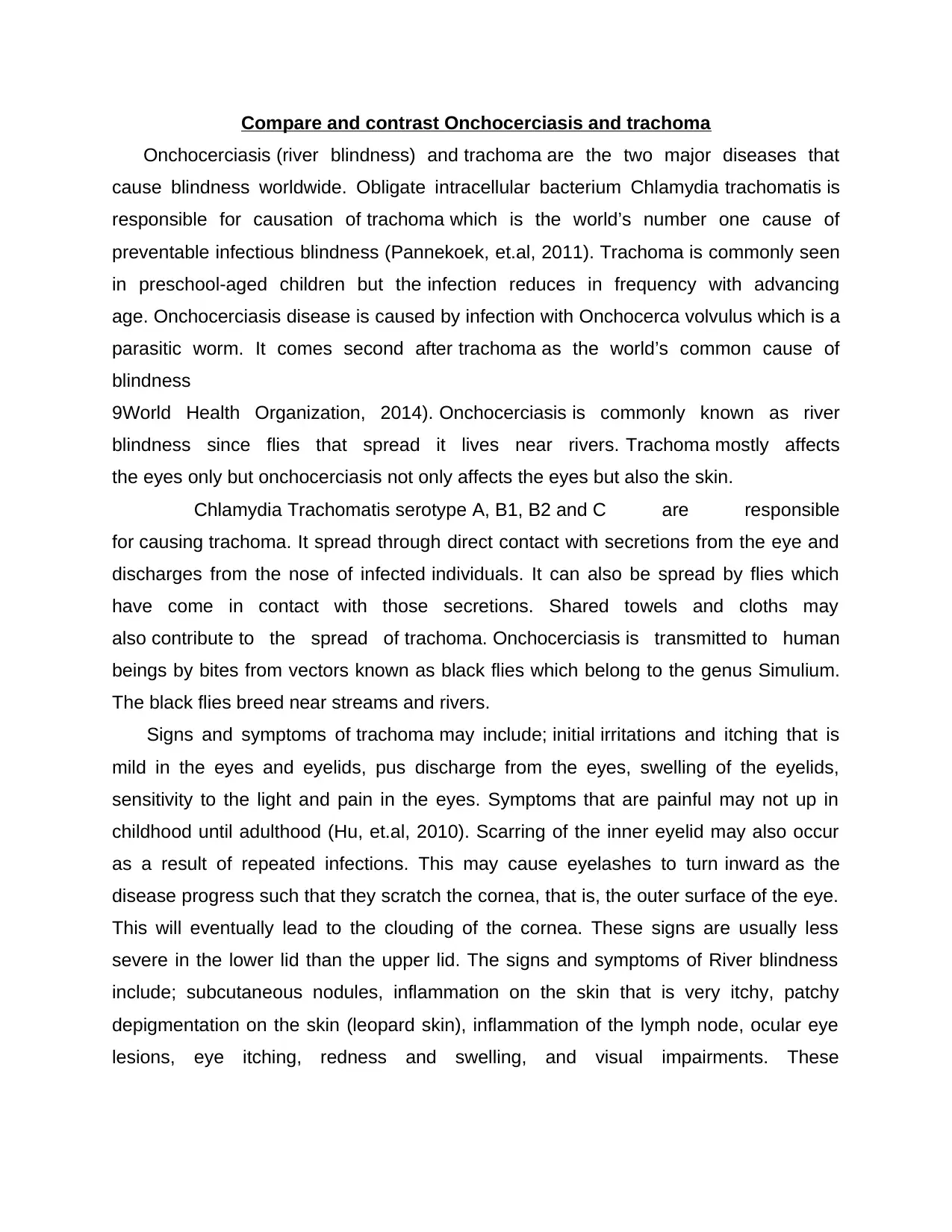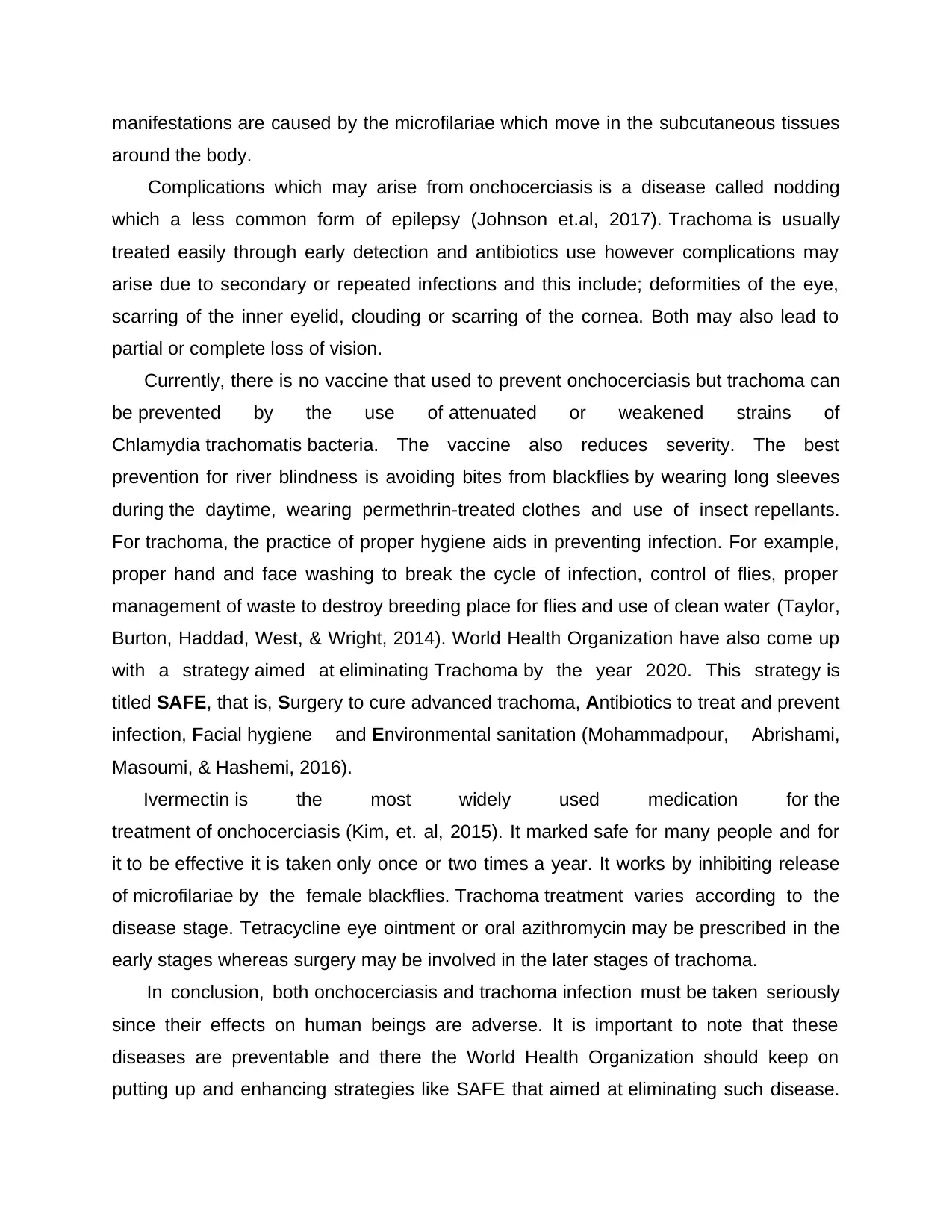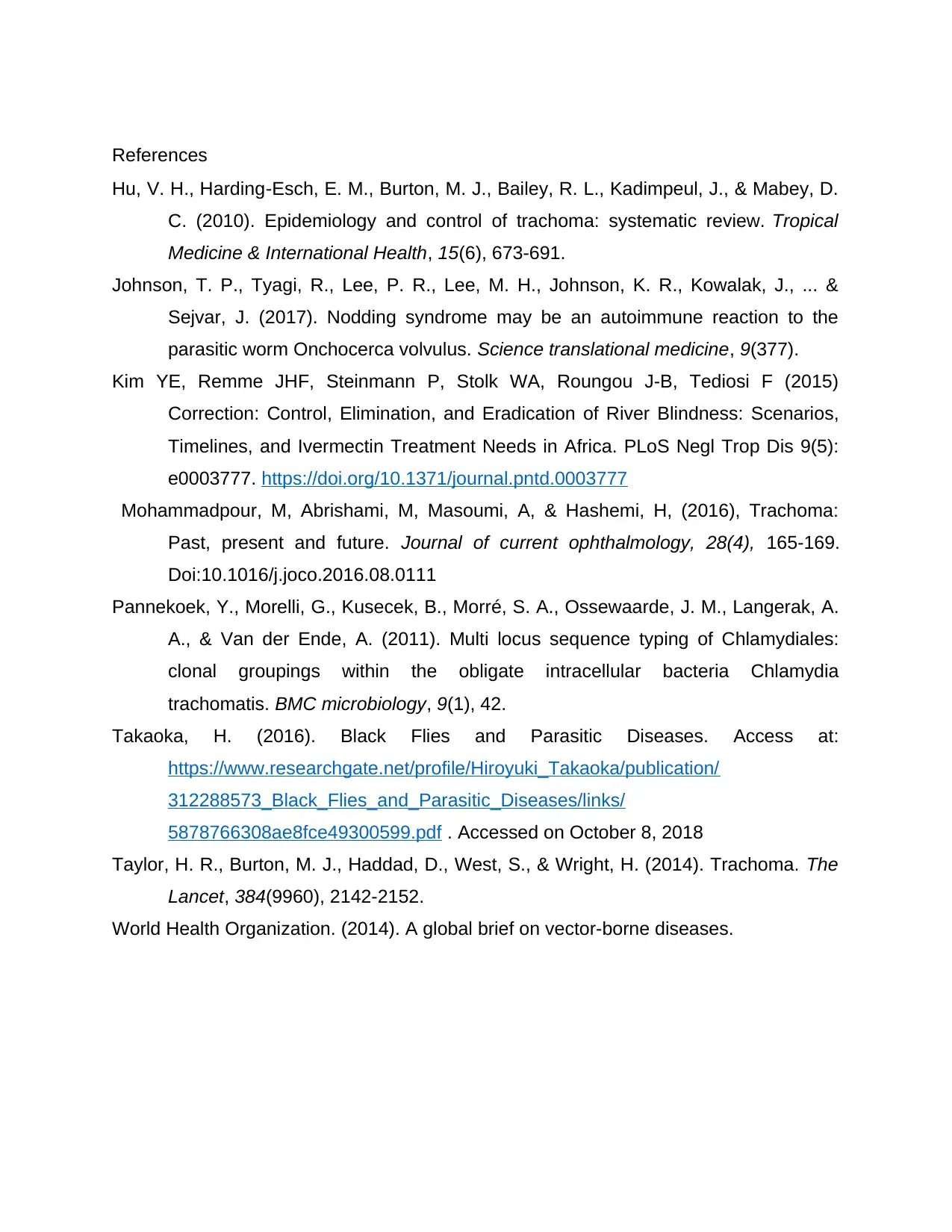Comparison of Onchocerciasis and Trachoma: Causes, Symptoms, and Prevention
VerifiedAdded on 2023/06/04
|5
|1254
|446
AI Summary
Onchocerciasis and trachoma are two major diseases that cause blindness worldwide. Onchocerciasis is caused by a parasitic worm, while trachoma is caused by Chlamydia trachomatis bacteria. Both diseases have different symptoms and prevention methods. Read on to learn more.
Contribute Materials
Your contribution can guide someone’s learning journey. Share your
documents today.

Nursing
Student’s name:
Institutional:
Student’s name:
Institutional:
Secure Best Marks with AI Grader
Need help grading? Try our AI Grader for instant feedback on your assignments.

Compare and contrast Onchocerciasis and trachoma
Onchocerciasis (river blindness) and trachoma are the two major diseases that
cause blindness worldwide. Obligate intracellular bacterium Chlamydia trachomatis is
responsible for causation of trachoma which is the world’s number one cause of
preventable infectious blindness (Pannekoek, et.al, 2011). Trachoma is commonly seen
in preschool-aged children but the infection reduces in frequency with advancing
age. Onchocerciasis disease is caused by infection with Onchocerca volvulus which is a
parasitic worm. It comes second after trachoma as the world’s common cause of
blindness
9World Health Organization, 2014). Onchocerciasis is commonly known as river
blindness since flies that spread it lives near rivers. Trachoma mostly affects
the eyes only but onchocerciasis not only affects the eyes but also the skin.
Chlamydia Trachomatis serotype A, B1, B2 and C are responsible
for causing trachoma. It spread through direct contact with secretions from the eye and
discharges from the nose of infected individuals. It can also be spread by flies which
have come in contact with those secretions. Shared towels and cloths may
also contribute to the spread of trachoma. Onchocerciasis is transmitted to human
beings by bites from vectors known as black flies which belong to the genus Simulium.
The black flies breed near streams and rivers.
Signs and symptoms of trachoma may include; initial irritations and itching that is
mild in the eyes and eyelids, pus discharge from the eyes, swelling of the eyelids,
sensitivity to the light and pain in the eyes. Symptoms that are painful may not up in
childhood until adulthood (Hu, et.al, 2010). Scarring of the inner eyelid may also occur
as a result of repeated infections. This may cause eyelashes to turn inward as the
disease progress such that they scratch the cornea, that is, the outer surface of the eye.
This will eventually lead to the clouding of the cornea. These signs are usually less
severe in the lower lid than the upper lid. The signs and symptoms of River blindness
include; subcutaneous nodules, inflammation on the skin that is very itchy, patchy
depigmentation on the skin (leopard skin), inflammation of the lymph node, ocular eye
lesions, eye itching, redness and swelling, and visual impairments. These
Onchocerciasis (river blindness) and trachoma are the two major diseases that
cause blindness worldwide. Obligate intracellular bacterium Chlamydia trachomatis is
responsible for causation of trachoma which is the world’s number one cause of
preventable infectious blindness (Pannekoek, et.al, 2011). Trachoma is commonly seen
in preschool-aged children but the infection reduces in frequency with advancing
age. Onchocerciasis disease is caused by infection with Onchocerca volvulus which is a
parasitic worm. It comes second after trachoma as the world’s common cause of
blindness
9World Health Organization, 2014). Onchocerciasis is commonly known as river
blindness since flies that spread it lives near rivers. Trachoma mostly affects
the eyes only but onchocerciasis not only affects the eyes but also the skin.
Chlamydia Trachomatis serotype A, B1, B2 and C are responsible
for causing trachoma. It spread through direct contact with secretions from the eye and
discharges from the nose of infected individuals. It can also be spread by flies which
have come in contact with those secretions. Shared towels and cloths may
also contribute to the spread of trachoma. Onchocerciasis is transmitted to human
beings by bites from vectors known as black flies which belong to the genus Simulium.
The black flies breed near streams and rivers.
Signs and symptoms of trachoma may include; initial irritations and itching that is
mild in the eyes and eyelids, pus discharge from the eyes, swelling of the eyelids,
sensitivity to the light and pain in the eyes. Symptoms that are painful may not up in
childhood until adulthood (Hu, et.al, 2010). Scarring of the inner eyelid may also occur
as a result of repeated infections. This may cause eyelashes to turn inward as the
disease progress such that they scratch the cornea, that is, the outer surface of the eye.
This will eventually lead to the clouding of the cornea. These signs are usually less
severe in the lower lid than the upper lid. The signs and symptoms of River blindness
include; subcutaneous nodules, inflammation on the skin that is very itchy, patchy
depigmentation on the skin (leopard skin), inflammation of the lymph node, ocular eye
lesions, eye itching, redness and swelling, and visual impairments. These

manifestations are caused by the microfilariae which move in the subcutaneous tissues
around the body.
Complications which may arise from onchocerciasis is a disease called nodding
which a less common form of epilepsy (Johnson et.al, 2017). Trachoma is usually
treated easily through early detection and antibiotics use however complications may
arise due to secondary or repeated infections and this include; deformities of the eye,
scarring of the inner eyelid, clouding or scarring of the cornea. Both may also lead to
partial or complete loss of vision.
Currently, there is no vaccine that used to prevent onchocerciasis but trachoma can
be prevented by the use of attenuated or weakened strains of
Chlamydia trachomatis bacteria. The vaccine also reduces severity. The best
prevention for river blindness is avoiding bites from blackflies by wearing long sleeves
during the daytime, wearing permethrin-treated clothes and use of insect repellants.
For trachoma, the practice of proper hygiene aids in preventing infection. For example,
proper hand and face washing to break the cycle of infection, control of flies, proper
management of waste to destroy breeding place for flies and use of clean water (Taylor,
Burton, Haddad, West, & Wright, 2014). World Health Organization have also come up
with a strategy aimed at eliminating Trachoma by the year 2020. This strategy is
titled SAFE, that is, Surgery to cure advanced trachoma, Antibiotics to treat and prevent
infection, Facial hygiene and Environmental sanitation (Mohammadpour, Abrishami,
Masoumi, & Hashemi, 2016).
Ivermectin is the most widely used medication for the
treatment of onchocerciasis (Kim, et. al, 2015). It marked safe for many people and for
it to be effective it is taken only once or two times a year. It works by inhibiting release
of microfilariae by the female blackflies. Trachoma treatment varies according to the
disease stage. Tetracycline eye ointment or oral azithromycin may be prescribed in the
early stages whereas surgery may be involved in the later stages of trachoma.
In conclusion, both onchocerciasis and trachoma infection must be taken seriously
since their effects on human beings are adverse. It is important to note that these
diseases are preventable and there the World Health Organization should keep on
putting up and enhancing strategies like SAFE that aimed at eliminating such disease.
around the body.
Complications which may arise from onchocerciasis is a disease called nodding
which a less common form of epilepsy (Johnson et.al, 2017). Trachoma is usually
treated easily through early detection and antibiotics use however complications may
arise due to secondary or repeated infections and this include; deformities of the eye,
scarring of the inner eyelid, clouding or scarring of the cornea. Both may also lead to
partial or complete loss of vision.
Currently, there is no vaccine that used to prevent onchocerciasis but trachoma can
be prevented by the use of attenuated or weakened strains of
Chlamydia trachomatis bacteria. The vaccine also reduces severity. The best
prevention for river blindness is avoiding bites from blackflies by wearing long sleeves
during the daytime, wearing permethrin-treated clothes and use of insect repellants.
For trachoma, the practice of proper hygiene aids in preventing infection. For example,
proper hand and face washing to break the cycle of infection, control of flies, proper
management of waste to destroy breeding place for flies and use of clean water (Taylor,
Burton, Haddad, West, & Wright, 2014). World Health Organization have also come up
with a strategy aimed at eliminating Trachoma by the year 2020. This strategy is
titled SAFE, that is, Surgery to cure advanced trachoma, Antibiotics to treat and prevent
infection, Facial hygiene and Environmental sanitation (Mohammadpour, Abrishami,
Masoumi, & Hashemi, 2016).
Ivermectin is the most widely used medication for the
treatment of onchocerciasis (Kim, et. al, 2015). It marked safe for many people and for
it to be effective it is taken only once or two times a year. It works by inhibiting release
of microfilariae by the female blackflies. Trachoma treatment varies according to the
disease stage. Tetracycline eye ointment or oral azithromycin may be prescribed in the
early stages whereas surgery may be involved in the later stages of trachoma.
In conclusion, both onchocerciasis and trachoma infection must be taken seriously
since their effects on human beings are adverse. It is important to note that these
diseases are preventable and there the World Health Organization should keep on
putting up and enhancing strategies like SAFE that aimed at eliminating such disease.

Each and every individual should also contribute towards achieving this goal of
eliminating those diseases by promoting good hygiene and proper health-
seeking behavior. This will greatly lead to the elimination or reduction of
both trachoma and onchocerciasis.
eliminating those diseases by promoting good hygiene and proper health-
seeking behavior. This will greatly lead to the elimination or reduction of
both trachoma and onchocerciasis.
Secure Best Marks with AI Grader
Need help grading? Try our AI Grader for instant feedback on your assignments.

References
Hu, V. H., Harding‐Esch, E. M., Burton, M. J., Bailey, R. L., Kadimpeul, J., & Mabey, D.
C. (2010). Epidemiology and control of trachoma: systematic review. Tropical
Medicine & International Health, 15(6), 673-691.
Johnson, T. P., Tyagi, R., Lee, P. R., Lee, M. H., Johnson, K. R., Kowalak, J., ... &
Sejvar, J. (2017). Nodding syndrome may be an autoimmune reaction to the
parasitic worm Onchocerca volvulus. Science translational medicine, 9(377).
Kim YE, Remme JHF, Steinmann P, Stolk WA, Roungou J-B, Tediosi F (2015)
Correction: Control, Elimination, and Eradication of River Blindness: Scenarios,
Timelines, and Ivermectin Treatment Needs in Africa. PLoS Negl Trop Dis 9(5):
e0003777. https://doi.org/10.1371/journal.pntd.0003777
Mohammadpour, M, Abrishami, M, Masoumi, A, & Hashemi, H, (2016), Trachoma:
Past, present and future. Journal of current ophthalmology, 28(4), 165-169.
Doi:10.1016/j.joco.2016.08.0111
Pannekoek, Y., Morelli, G., Kusecek, B., Morré, S. A., Ossewaarde, J. M., Langerak, A.
A., & Van der Ende, A. (2011). Multi locus sequence typing of Chlamydiales:
clonal groupings within the obligate intracellular bacteria Chlamydia
trachomatis. BMC microbiology, 9(1), 42.
Takaoka, H. (2016). Black Flies and Parasitic Diseases. Access at:
https://www.researchgate.net/profile/Hiroyuki_Takaoka/publication/
312288573_Black_Flies_and_Parasitic_Diseases/links/
5878766308ae8fce49300599.pdf . Accessed on October 8, 2018
Taylor, H. R., Burton, M. J., Haddad, D., West, S., & Wright, H. (2014). Trachoma. The
Lancet, 384(9960), 2142-2152.
World Health Organization. (2014). A global brief on vector-borne diseases.
Hu, V. H., Harding‐Esch, E. M., Burton, M. J., Bailey, R. L., Kadimpeul, J., & Mabey, D.
C. (2010). Epidemiology and control of trachoma: systematic review. Tropical
Medicine & International Health, 15(6), 673-691.
Johnson, T. P., Tyagi, R., Lee, P. R., Lee, M. H., Johnson, K. R., Kowalak, J., ... &
Sejvar, J. (2017). Nodding syndrome may be an autoimmune reaction to the
parasitic worm Onchocerca volvulus. Science translational medicine, 9(377).
Kim YE, Remme JHF, Steinmann P, Stolk WA, Roungou J-B, Tediosi F (2015)
Correction: Control, Elimination, and Eradication of River Blindness: Scenarios,
Timelines, and Ivermectin Treatment Needs in Africa. PLoS Negl Trop Dis 9(5):
e0003777. https://doi.org/10.1371/journal.pntd.0003777
Mohammadpour, M, Abrishami, M, Masoumi, A, & Hashemi, H, (2016), Trachoma:
Past, present and future. Journal of current ophthalmology, 28(4), 165-169.
Doi:10.1016/j.joco.2016.08.0111
Pannekoek, Y., Morelli, G., Kusecek, B., Morré, S. A., Ossewaarde, J. M., Langerak, A.
A., & Van der Ende, A. (2011). Multi locus sequence typing of Chlamydiales:
clonal groupings within the obligate intracellular bacteria Chlamydia
trachomatis. BMC microbiology, 9(1), 42.
Takaoka, H. (2016). Black Flies and Parasitic Diseases. Access at:
https://www.researchgate.net/profile/Hiroyuki_Takaoka/publication/
312288573_Black_Flies_and_Parasitic_Diseases/links/
5878766308ae8fce49300599.pdf . Accessed on October 8, 2018
Taylor, H. R., Burton, M. J., Haddad, D., West, S., & Wright, H. (2014). Trachoma. The
Lancet, 384(9960), 2142-2152.
World Health Organization. (2014). A global brief on vector-borne diseases.
1 out of 5
Your All-in-One AI-Powered Toolkit for Academic Success.
+13062052269
info@desklib.com
Available 24*7 on WhatsApp / Email
![[object Object]](/_next/static/media/star-bottom.7253800d.svg)
Unlock your academic potential
© 2024 | Zucol Services PVT LTD | All rights reserved.

